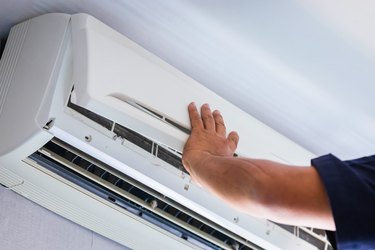
Condensation and water problems are common with air conditioning systems for the simple reason that warm air can hold more moisture than cold air. As the air circulating around the AC evaporator coils cools down, moisture tends to condense and collect on the coils. Air conditioners and air conditioning systems always include a drainage system to route this water out of the house, but if the drainage pipe gets blocked or the system isn't working properly, the air conditioner will drip onto the floor. Pools of standing water, mold and rot are the usual results.
The air ducts in a central air system are also subject to condensation, especially if they are made of metal and are uninsulated. There's a temperature differential between the inside and outside of the duct, and condensation occurs on the warmer side as warm air hits the cold metal. This is one of the main reasons air ducts get moldy.
Video of the Day
Video of the Day
Condensation in the Main AC Unit
Excessive condensation inside an air conditioner is often the result of dirty air filters that are restricting airflow. When air circulation is good, excess condensation can evaporate and get circulated out of the unit by the blower, but if the air isn't moving, it collects on the coils where it often freezes, which only compounds the problem. So, cleaning or replacing the air filters is one of the first things to do to stop dripping.
Underneath the coils is a drip pan connected to a drain tube, and the pan has to be tilted toward the drain. If the pan loses its tilt, which often happens with a window air conditioner, water accumulates in the pan and can eventually begin to spill over the side. To maintain the drainage system, make sure the pan is tilted and clean the drain hose by periodically pouring 6 ounces of vinegar into it to kill algae and dissolve scale.
Clogged Drain Pipe
If your window air conditioner drain line is clogged and water is dripping from the drain pan, you can usually clear the clog by poking a piece of wire or a barbed cable drain cleaning tool into the drain opening. A central air system usually has a 3/4-inch drain that extends through the wall, and it's usually too long to clean this way, but you can do the job with a wet/dry vacuum cleaner.
You'll need an adapter to convert the 2 1/2-inch vacuum hose to the 3/4-inch drain pipe, but if you don't have one, you can usually insert the smaller pipe into the larger one and seal the opening with duct tape. Once the connection is airtight, turn on the vacuum and let it run for three minutes to extract all the debris in the pipe.
Condensate in the Air Ducts
Condensate in the air ducts is also the result of dirty air filters that are restricting airflow, so regularly replacing your system's air filters is a must. However, on days of high humidity, the air may be too moist for this to make a difference, so you should also consider wrapping your exposed metal ducts with insulation to reduce the temperature differential.
The easiest duct wrap to use is foil-encased fiberglass. Wrap it around the outside of any duct that is dripping water and secure it with aluminum foil tape or conventional duct tape. If the duct has been dripping for some time, mold may be growing inside. The best way to remove mold is to wash it off with soapy water, and by insulating the duct to keep it dry, you'll also prevent the mold from growing back.